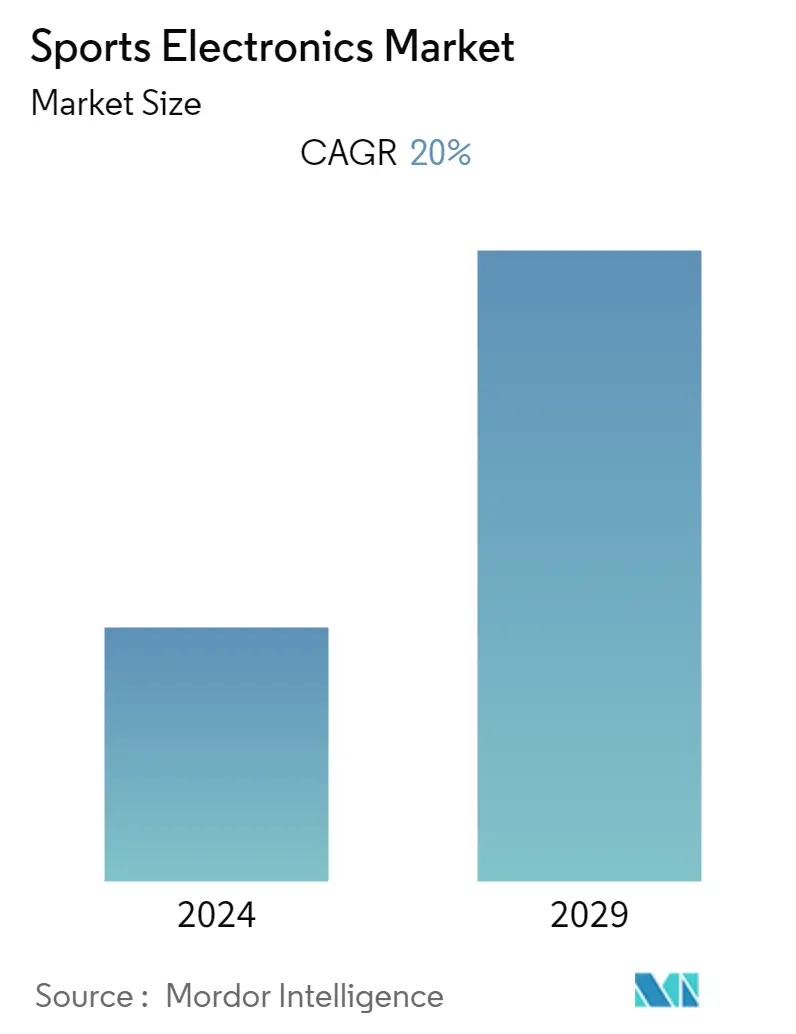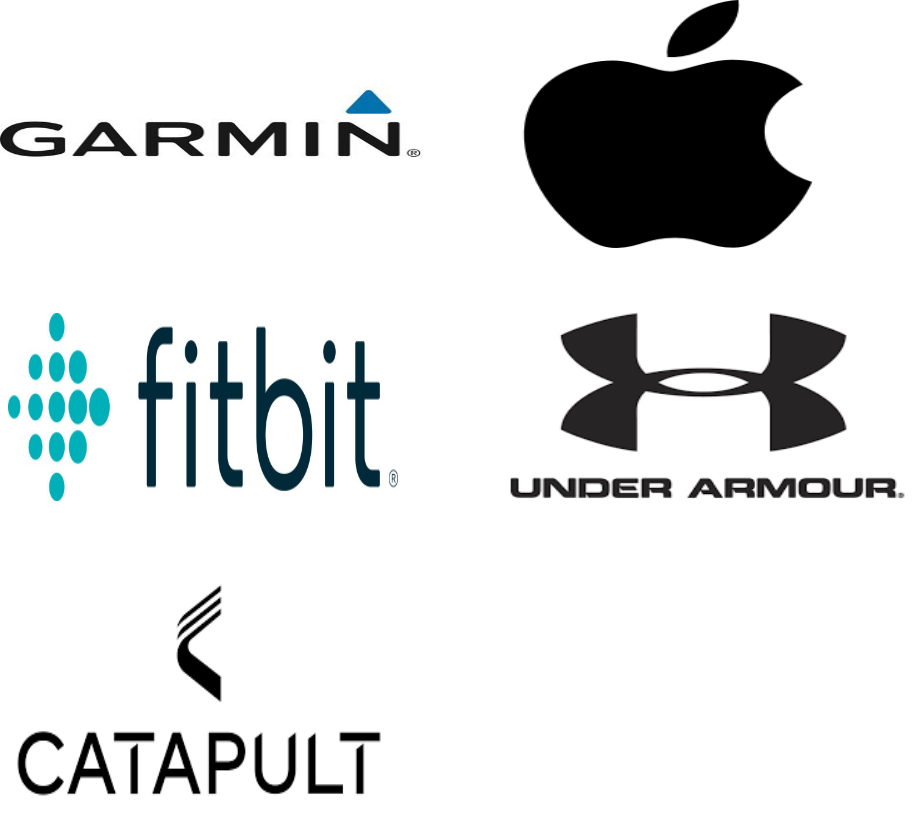Market Size of Sports Electronics Industry

| Study Period | 2019 - 2029 |
| Base Year For Estimation | 2023 |
| CAGR | 20.00 % |
| Fastest Growing Market | Asia Pacific |
| Largest Market | North America |
| Market Concentration | Low |
Major Players
*Disclaimer: Major Players sorted in no particular order |
Sports Electronics Market Analysis
The sports electronics market is expected to register a CAGR of 20%, during the forecast period 2021-2026. According to the World Health Organization, each week an adult should perform the moderate intensity of physical activities ( PA ) for 150 minutes. However, 25% of adults and more than 80% of adolescents fail to achieve the recommended PA targets. Thus, the need for monitoring the physical activities is increasing among the consumers, thereby increasing the adoption of the activity tracker.
- According to the Outdoor Industry Association, activewear was one of the most sold sports retail good in 2018. Activewear alone accounted for USD 53 billion in 2018. Observing the increasing demand for activewear, companies are investing in the segment and are introducing interactive activewear which is creating a positive outlook of the market.
- For instance, in November 2018, Pivot Yoga, a smart activewear company launched a smart activewear for yoga lovers which was equipped with artificial intelligence and motion sensor technology. This smart activewear helps in correcting yoga posture through the use of the Pivot app.
- Moreover, in a high-intensity interval training, injuries are common, owing to which the companies are working to design a device which directly identifies muscle strain thereby reducing any recurring injury. For instance, in 2017, the NFL Player's Association (NFLPA) formed a partnership with WHOOP to offer every player with a wearable device enabling monitoring features such as strain, recovery, and sleep.
- However, lack of awareness about the importance of the product, coupled with the high cost of smart sports electronics product is restraining the growth of the market.
Sports Electronics Industry Segmentation
The sports electronics devices are an important part of the sports industry because the devices help the sportsperson to track their fitness activities and further helps in providing relevant information regarding the different parameters. With the commercialization of the sports industry, manufacturers are innovating and launching new products to cater to every demand in the industry.
| By Product Type | |||||||
| |||||||
|
| Geography | |
| North America | |
| Europe | |
| Asia-Pacific | |
| Latin America | |
| Middle East & Africa |
Sports Electronics Market Size Summary
The sports electronics market is experiencing significant growth, driven by the increasing demand for activity trackers and smart wearables. This surge is largely attributed to the rising awareness of the importance of physical activity and health monitoring among consumers. The market is characterized by the introduction of innovative products such as interactive activewear and advanced smartwatches, which are equipped with features like artificial intelligence, motion sensors, and health monitoring capabilities. These advancements are not only enhancing the user experience but also encouraging more individuals to engage in physical activities. However, the market faces challenges such as high costs and limited awareness, which could potentially hinder its growth trajectory.
The Asia-Pacific region is poised for rapid expansion in the sports electronics market, fueled by the presence of large populations in countries like China and India. The region's growth is further supported by favorable business conditions and government initiatives that encourage innovation and entrepreneurship. Global players are increasingly focusing on this region to capitalize on the burgeoning market opportunities. The market is highly competitive, with major companies like Fitbit, Garmin, and Apple actively pursuing strategies such as product launches, partnerships, and expansions to strengthen their market presence. These efforts are contributing to the overall positive outlook of the sports electronics industry, as it continues to evolve and adapt to consumer needs and technological advancements.
Sports Electronics Market Size - Table of Contents
-
1. MARKET DYNAMICS
-
1.1 Market Overview
-
1.2 Introduction to Market Drivers and Restraints
-
1.3 Market Drivers
-
1.3.1 Technological Advancements in Wearable Sports Devices
-
1.3.2 Rising Demand for Round-The-Clock Monitoring
-
-
1.4 Market Restraints
-
1.4.1 High Cost of Wearable Devices
-
-
1.5 Industry Value Chain Analysis
-
1.6 Industry Attractiveness - Porter's Five Force Analysis
-
1.6.1 Threat of New Entrants
-
1.6.2 Bargaining Power of Buyers/Consumers
-
1.6.3 Bargaining Power of Suppliers
-
1.6.4 Threat of Substitute Products
-
1.6.5 Intensity of Competitive Rivalry
-
-
-
2. MARKET SEGMENTATION
-
2.1 By Product Type
-
2.1.1 Wearable Devices
-
2.1.1.1 Pedometers
-
2.1.1.2 Activity Monitors
-
2.1.1.3 Smart Fabrics
-
2.1.1.4 Fitness and Heart Rate Monitors
-
2.1.1.5 Other Wearable Devices
-
-
2.1.2 Standalone Devices
-
2.1.2.1 Electronics Scales
-
2.1.2.2 Cameras
-
2.1.2.3 Cycling Computers
-
2.1.2.4 Other Standalone Devices
-
-
-
2.2 Geography
-
2.2.1 North America
-
2.2.2 Europe
-
2.2.3 Asia-Pacific
-
2.2.4 Latin America
-
2.2.5 Middle East & Africa
-
-
Sports Electronics Market Size FAQs
What is the current Sports Electronics Market size?
The Sports Electronics Market is projected to register a CAGR of 20% during the forecast period (2024-2029)
Who are the key players in Sports Electronics Market?
Fitbit, Inc, Garmin Ltd, Apple Inc, Under Armour, Inc and Catapult Sports are the major companies operating in the Sports Electronics Market.

